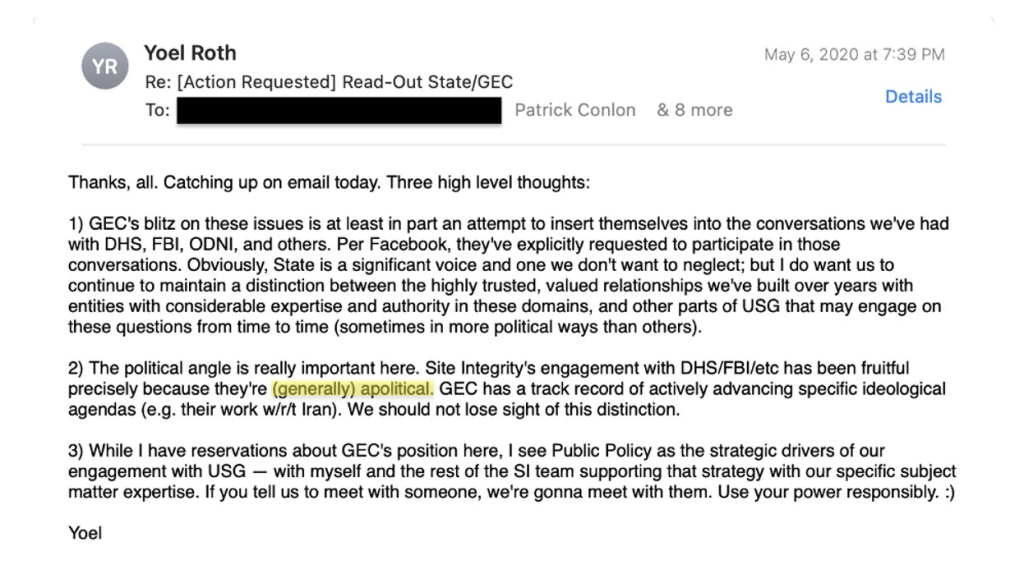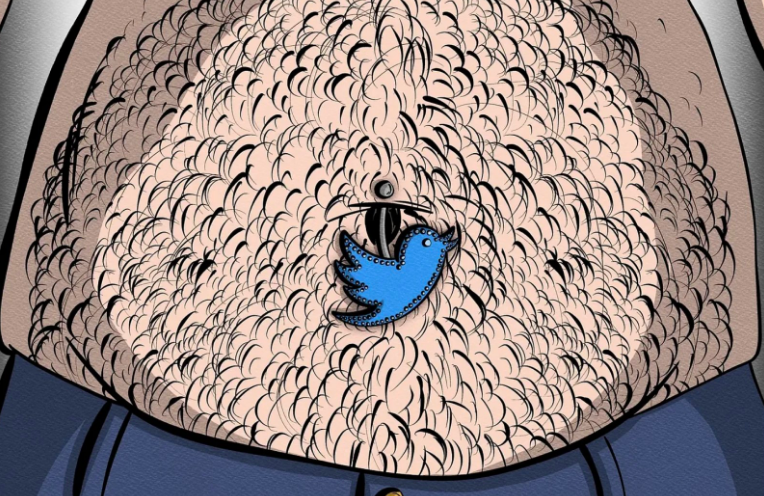The latest installment of the Twitter Files revealed the FBI’s desire for Twitter to rely on it to be the belly button of the U.S. government (USG). The first Twitter Files installment of 2023 revealed shared the events that led up to the intelligence community’s influence on Twitter. Following that installment, journalist Matt Taibbi released another, which revealed the Global Engagement Center’s (GEC) role.
Taibbi described the GEC as “a fledgling analytic/intelligence arms of the State Department,” and screenshots revealed how this new entity would go directly to the media. In one such instance, a report titled, Russian Disinformation Apparatus Taking Advantage of Coronavirus Concerns, was released, which wrecked a bit of havoc for Twitter.
1.THREAD: The Twitter Files
Twitter and the FBI “Belly Button” pic.twitter.com/nfOGQGlvUM— Matt Taibbi (@mtaibbi) January 3, 2023
Twitter’s then Trust and Safety head, Yoel Roth, pointed out the motives of Clemson’s Media Forensic Hub when it complained that Twitter hadn’t “made a Russia attribution” in some time.

Credit: Matt Taibbi

Credit: Matt Taibbi
Roth told researchers like Clemson that Twitter would be happy to work directly with them instead of the media. He was unsuccessful. Simultaneously, Twitter was trying to reduce the number of agencies that had access to Roth. Twitter’s then-policy director, Carlos Monje, pointed out that once Twitter gave these agencies, such as the Department of Homeland Security, access to Roth.
“If these folks are like House Homeland Committee and DHS, once we give them direct contact with Yoel, they will want to come back to him again and again,” Monje said.
Taibbi noted that the GEC report appeared to be based on DHS data that was circulated earlier that week. The data included accounts that followed two or more Chinese diplomatic accounts and ended up with a list “nearly 250,000” names long. The list included Canadian officials and a CNN account.

Credit: Matt Taibbi
In an email, Roth said that the GEC attempted to insert itself into conversations Twitter had with several government agencies, including the FBI and DHS. The GEC began to agree to loop Twitter in before going public; however, the agency used a technique that trapped Twitter previously.
“The delta between when they share material and when they go to the press continues to be problematic,” a comms official wrote, adding that they primed the media to be “curios and inquisitive of this dynamic, too.”

Credit: Matt Taibbi
This led to Twitter’s disputing a State Department claim that China coordinated coronavirus disinformation accounts. The FBI then informed Twitter that the GEC wanted to be included in their regular “industry call” between companies like Twitter and Facebook and the DHS and FBI. At first, Twitter didn’t want to go this route. Executives at Facebook and Google were united with Twitter in its opposition to the GEC’s inclusion.
“The GEC’s mandate for offensive IO to promote American interests. The relative lack of discretion and caution from senior GEC leadership in sharing reports/analysis based on shaky methodology. A limited track record of successful collaboration with industry.”
Roth noted that an actor such as GEC being introduced to a stable and trusted group of practitioners and experts, especially with the election heating up, posed major risks.

Credit: Matt Taibbi
Roth added that another reason was that the DHS and FBI were “apolitical,” whereas the GEC was “political.”
“GEC has a track record of actively advancing specific ideological agendas (e.g., their work w/r/t Iran). We should not lose sight of this distinction,” Roth wrote.

Credit: Matt Taibbi
The FBI argued for a compromise solution that would allow other U.S. government (USG) agencies to participate in the industry calls, with the FBI and DHS acting as sole conduits. When Roth reached out to FBI agent Elvis Chan with concerns, Chan reassured the Twitter executive that it would be a “one-way” channel and “State/GEC, NSA, and CIA have expressed interest in being allowed on in listen mode only.”
“We can give you everything we’re seeing from the FBI and USIC agencies,” Chan told Roth, adding that the DHS agency Cybersecurity and Infrastructure Security Agency (CISA) “will know what’s going on in each state.” Chan then asked if the industry could “rely on the FBI to be the belly button of the USG.”

Credit: Matt Taibbi
The group eventually chose Signal due to its operational security. Following that, Twitter began taking requests from various government bodies starting with the Senate Intel Committee (SSCI), which needed reassurance that Twitter was taking FBI direction.
Twitter also received various requests from officials wanting individuals they didn’t like to be banned from the platform. In the screenshot below, the office for Democrat and House Intel Committee chief Adam Schiff asked Twitter to ban journalist Paul Sperry.

Credit: Matt Taibbi
At the time, Twitter refused. However, Sperry was later suspended. “No, this isn’t feasible/we don’t do this,” Twitter replied.

Twitter honored many of the requests, including those from the GEC, to ban accounts the GEC identified as “GRU-controlled” and linked “to the Russian government.”
A former CIA staffer working at Twitter called the GEC requests “Our window on that is closing,” which meant that the days Twitter could say no to serious requests were over. In the Twitter Files that were released earlier today, Taibbi noted that in public, Twitter would remove content at its “sole discretion.”
Privately, the platform would “off-board” anything that was “identified by the U.S. intelligence community as state-sponsored entity conducting cyber-operations.” That was in 2017. By 2020, agencies were flooding Twitter with “identifications” or users that it wanted Twitter to remove.

Credit: Matt Taibbi
Taibbi pointed out that some reports were only a paragraph long and that Twitter would be forwarded an Excel document without further explanation. Twitter was also warned about the publicity surrounding a book written by former Ukraine prosecutor Viktor Shokhin, who alleged “corruption by the U.S. government” – specifically by Joe Biden.
Screenshots reveal that by mere weeks before the 2020 election, Twitter was so confused by the multiple streams of incoming requests that staffers had to ask the FBI which was which.

Credit: Matt Taibbi
Taibbi noted that this led to the situation described in an earlier Twitter Files release by Michael Shellenberger on December 19, 2022.
In that release, it was revealed that Twitter was paid $3,415,323. Taibbi noted that Twitter wasn’t just paid but underpaid for the amount of work it did for the government.
Your feedback is welcome. If you have any comments or concerns or see a typo, you can email me at johnna@teslarati.com. You can also reach me on Twitter at @JohnnaCrider1.
Teslarati is now on TikTok. Follow us for interactive news & more. Teslarati is now on TikTok. Follow us for interactive news & more. You can also follow Teslarati on LinkedIn, Twitter, Instagram, and Facebook.

Elon Musk
Tesla CEO Elon Musk teases insane capabilities of next major FSD update

Tesla CEO Elon Musk teased the insane capabilities of the next major Full Self-Driving update just hours after the company rolled out version 14.2 to owners.
Tesla Full Self-Driving v14.2 had some major improvements from the previous iteration of v14.1.x. We were on v14.1.7, the most advanced configuration of the v14.1 family, before Tesla transitioned us and others to v14.2.
However, Musk has said that the improvements coming in the next major update, which will be v14.3, will be where “the last big piece of the puzzle finally lands.”
14.3 is where the last big piece of the puzzle finally lands
— Elon Musk (@elonmusk) November 21, 2025
There were some major improvements with v14.2, most notably, Tesla seemed to narrow in on the triggers that caused issues with hesitation and brake stabbing in v14.1.x.
One of the most discussed issues with the past rollout was that of brake stabbing, where the vehicle would contemplate proceeding with a route as traffic was coming from other directions.
We experienced it most frequently at intersections, especially four-way stop signs.
Elon Musk hints at when Tesla can fix this FSD complaint with v14
In our review of it yesterday, it was evident that this issue had been resolved, at least to the extent that we had no issues with it in a 62-minute drive, which you can watch here.
Some owners also reported a more relaxed driver monitoring system, which is something Tesla said it was working on as it hopes to allow drivers to text during operation in the coming months. We did not test this, as laws in Pennsylvania prohibit the use of phones at any time due to the new Paul Miller’s Law, which took effect earlier this year.
However, the improvements indicate that Tesla is certainly headed toward a much more sentient FSD experience, so much so that Musk’s language seems to be more indicative of a more relaxed experience in terms of overall supervision from the driver, especially with v14.3.
Musk did not release or discuss a definitive timeline for the release of v14.3, especially as v14.2 just rolled out to Early Access Program (EAP) members yesterday. However, v14.1 rolled out to Tesla owners just a few weeks ago in late 2025. There is the potential that v14.3 could be part of the coming Holiday Update, or potentially in a release of its own before the New Year.
News
Tesla Full Self-Driving v14.2 – Full Review, the Good and the Bad

Tesla rolled out Full Self-Driving version 14.2 yesterday to members of the Early Access Program (EAP). Expectations were high, and Tesla surely delivered.
With the rollout of Tesla FSD v14.2, there were major benchmarks for improvement from the v14.1 suite, which spanned across seven improvements. Our final experience with v14.1 was with v14.1.7, and to be honest, things were good, but it felt like there were a handful of regressions from previous iterations.
While there were improvements in brake stabbing and hesitation, we did experience a few small interventions related to navigation and just overall performance. It was nothing major; there were no critical takeovers that required any major publicity, as they were more or less subjective things that I was not particularly comfortable with. Other drivers might have been more relaxed.
With v14.2 hitting our cars yesterday, there were a handful of things we truly noticed in terms of improvement, most notably the lack of brake stabbing and hesitation, a major complaint with v14.1.x.
However, in a 62-minute drive that was fully recorded, there were a lot of positives, and only one true complaint, which was something we haven’t had issues with in the past.
The Good
Lack of Brake Stabbing and Hesitation
Perhaps the most notable and publicized issue with v14.1.x was the presence of brake stabbing and hesitation. Arriving at intersections was particularly nerve-racking on the previous version simply because of this. At four-way stops, the car would not be assertive enough to take its turn, especially when other vehicles at the same intersection would inch forward or start to move.
This was a major problem.
However, there were no instances of this yesterday on our lengthy drive. It was much more assertive when arriving at these types of scenarios, but was also more patient when FSD knew it was not the car’s turn to proceed.
Can report on v14.2 today there were ZERO instances of break stabbing or hesitation at intersections today
It was a significant improvement from v14.1.x
— TESLARATI (@Teslarati) November 21, 2025
This improvement was the most noticeable throughout the drive, along with fixes in overall smoothness.
Speed Profiles Seem to Be More Reasonable
There were a handful of FSD v14 users who felt as if the loss of a Max Speed setting was a negative. However, these complaints will, in our opinion, begin to subside, especially as things have seemed to be refined quite nicely with v14.2.
Freeway driving is where this is especially noticeable. If it’s traveling too slow, just switch to a faster profile. If it’s too fast, switch to a slower profile. However, the speeds seem to be much more defined with each Speed Profile, which is something that I really find to be a huge advantage. Previously, you could tell the difference in speeds, but not in driving styles. At times, Standard felt a lot like Hurry. Now, you can clearly tell the difference between the two.
It seems as if Tesla made a goal that drivers should be able to tell which Speed Profile is active if it was not shown on the screen. With v14.1.x, this was not necessarily something that could be done. With v14.2, if someone tested me on which Speed Profile was being used, I’m fairly certain I could pick each one.
Better Overall Operation
I felt, at times, especially with v14.1.7, there were some jerky movements. Nothing that was super alarming, but there were times when things just felt a little more finicky than others.
v14.2 feels much smoother overall, with really great decision-making, lane changes that feel second nature, and a great speed of travel. It was a very comfortable ride.
The Bad
Parking
It feels as if there was a slight regression in parking quality, as both times v14.2 pulled into parking spots, I would have felt compelled to adjust manually if I were staying at my destinations. For the sake of testing, at my first destination, I arrived, allowed the car to park, and then left. At the tail-end of testing, I walked inside the store that FSD v14.2 drove me to, so I had to adjust the parking manually.
This was pretty disappointing. Apart from parking at Superchargers, which is always flawless, parking performance is something that needs some attention. The release notes for v14.2. state that parking spot selection and parking quality will improve with future versions.
Any issues with parking on your end? 14.1.7 didn’t have this trouble with parking pic.twitter.com/JPLRO2obUj
— TESLARATI (@Teslarati) November 21, 2025
However, this was truly my only complaint about v14.2.
You can check out our full 62-minute ride-along below:
Elon Musk
SpaceX issues statement on Starship V3 Booster 18 anomaly
The incident unfolded during gas-system pressure testing at the company’s Massey facility in Starbase, Texas.

SpaceX has issued an initial statement about Starship Booster 18’s anomaly early Friday. The incident unfolded during gas-system pressure testing at the company’s Massey facility in Starbase, Texas.
SpaceX’s initial comment
As per SpaceX in a post on its official account on social media platform X, Booster 18 was undergoing gas system pressure tests when the anomaly happened. Despite the nature of the incident, the company emphasized that no propellant was loaded, no engines were installed, and personnel were kept at a safe distance from the booster, resulting in zero injuries.
“Booster 18 suffered an anomaly during gas system pressure testing that we were conducting in advance of structural proof testing. No propellant was on the vehicle, and engines were not yet installed. The teams need time to investigate before we are confident of the cause. No one was injured as we maintain a safe distance for personnel during this type of testing. The site remains clear and we are working plans to safely reenter the site,” SpaceX wrote in its post on X.
Incident and aftermath
Livestream footage from LabPadre showed Booster 18’s lower half crumpling around the liquid oxygen tank area at approximately 4:04 a.m. CT. Subsequent images posted by on-site observers revealed extensive deformation across the booster’s lower structure. Needless to say, spaceflight observers have noted that Booster 18 would likely be a complete loss due to its anomaly.
Booster 18 had rolled out only a day earlier and was one of the first vehicles in the Starship V3 program. The V3 series incorporates structural reinforcements and reliability upgrades intended to prepare Starship for rapid-reuse testing and eventual tower-catch operations. Elon Musk has been optimistic about Starship V3, previously noting on X that the spacecraft might be able to complete initial missions to Mars.










